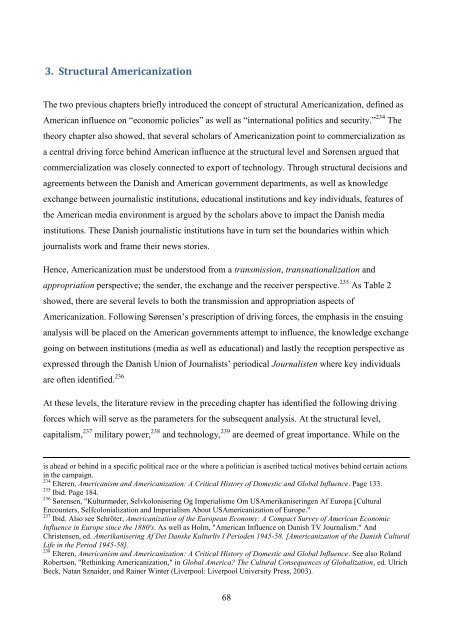The Jeremiad Over Journalism
The Jeremiad Over Journalism
The Jeremiad Over Journalism
You also want an ePaper? Increase the reach of your titles
YUMPU automatically turns print PDFs into web optimized ePapers that Google loves.
3. Structural Americanization<br />
<strong>The</strong> two previous chapters briefly introduced the concept of structural Americanization, defined as<br />
American influence on ―economic policies‖ as well as ―international politics and security.‖ 234 <strong>The</strong><br />
theory chapter also showed, that several scholars of Americanization point to commercialization as<br />
a central driving force behind American influence at the structural level and Sørensen argued that<br />
commercialization was closely connected to export of technology. Through structural decisions and<br />
agreements between the Danish and American government departments, as well as knowledge<br />
exchange between journalistic institutions, educational institutions and key individuals, features of<br />
the American media environment is argued by the scholars above to impact the Danish media<br />
institutions. <strong>The</strong>se Danish journalistic institutions have in turn set the boundaries within which<br />
journalists work and frame their news stories.<br />
Hence, Americanization must be understood from a transmission, transnationalization and<br />
appropriation perspective; the sender, the exchange and the receiver perspective. 235 As Table 2<br />
showed, there are several levels to both the transmission and appropriation aspects of<br />
Americanization. Following Sørensen‘s prescription of driving forces, the emphasis in the ensuing<br />
analysis will be placed on the American governments attempt to influence, the knowledge exchange<br />
going on between institutions (media as well as educational) and lastly the reception perspective as<br />
expressed through the Danish Union of Journalists‘ periodical Journalisten where key individuals<br />
are often identified. 236<br />
At these levels, the literature review in the preceding chapter has identified the following driving<br />
forces which will serve as the parameters for the subsequent analysis. At the structural level,<br />
capitalism, 237 military power, 238 and technology, 239 are deemed of great importance. While on the<br />
is ahead or behind in a specific political race or the where a politician is ascribed tactical motives behind certain actions<br />
in the campaign.<br />
234<br />
Elteren, Americanism and Americanization: A Critical History of Domestic and Global Influence. Page 133.<br />
235<br />
Ibid. Page 184.<br />
236<br />
Sørensen, "Kulturmøder, Selvkolonisering Og Imperialisme Om USAmerikaniseringen Af Europa [Cultural<br />
Encounters, Selfcolonialization and Imperialism About USAmericanization of Europe."<br />
237<br />
Ibid. Also see Schröter, Americanization of the European Economy: A Compact Survey of American Economic<br />
Influence in Europe since the 1880's. As well as Holm, "American Influence on Danish TV <strong>Journalism</strong>." And<br />
Christensen, ed. Amerikanisering Af Det Danske Kulturliv I Perioden 1945-58. [Americanization of the Danish Cultural<br />
Life in the Period 1945-58].<br />
238<br />
Elteren, Americanism and Americanization: A Critical History of Domestic and Global Influence. See also Roland<br />
Robertson, "Rethinking Americanization," in Global America? <strong>The</strong> Cultural Consequences of Globalization, ed. Ulrich<br />
Beck, Natan Sznaider, and Rainer Winter (Liverpool: Liverpool University Press, 2003).<br />
68
















